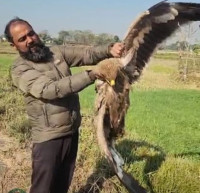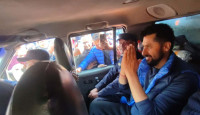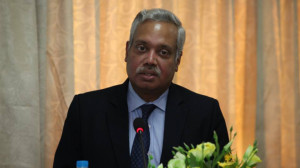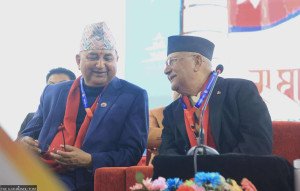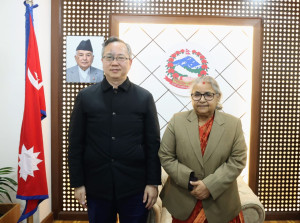Lab technicians from the National Public Health Laboratory on Sunday collected specimens—nasal and throat swab— from all 175 Nepalis who were evacuated from Hubei Province of China.
The 175 Nepalis had landed in Kathmandu on early Sunday morning in a Nepal Airlines plane that had flown to Wuhan, the capital of Hubei Province, the epicentre of the coronavirus outbreak that has killed at least 1,665 people across the globe, a vast majority in China, and infected 68,000 since it was first detected in December last year.
"We will carry out tests on the specimens on Monday," Dr Runa Jha, director at the laboratory, told the Post."Tests were not possible today, as it took several hours to collect the specimens."
Of the 175 Nepalis who returned from China, 170 are students, one is an employee, two are visitors, and two are children, according to the Embassy of Nepal in China.
Six Nepalis were barred from boarding the plane after they were detected with fever. Similarly, four others who had expressed their desire to return home decided to stay back in Hubei, according to a press release issued by the embassy.
All the evacuees were taken to the Nepal Electricity Authority training centre in Kharipati, Bhaktapur, which has been converted into a quarantine facility. Their temperatures were measured at the airfield by doctors deployed from Army Hospital before they were taken to Kharipati, according to Dr Nishant Thakur, chief of health desk set up at the Tribhuvan International Airport.
A team of 17 members, including four Nepal Army doctors, had gone to Wuhan on Saturday to evacuate the Nepalis.
The returning Nepalis were scattered across Hubei Province—55 were in Wuhan, 26 in Enshi, 29 in Shiyan, eight in Yichang, nine in Jingmen, and 48 in Jingzhou. Of them, 134 are males and 41 are females.
The Ministry of Health and Population said that the World Health Organization's guidelines have been followed while quarantining the evacuees. The males and females have been kept in separately.
"We feel very much safe here in our own country compared to Wuhan," Saurav Luitel, a local of Birat Chowk of Morang district, who was one of the evacuees, told the Post, over the phone from the quarantine centre. "Health workers today visited the quarantine facility to collect nasal and throat samples."
Luitel, who has been pursuing his master’s in plant pathology at the Huazhong Agriculture University, said that it was tough staying indoors for one and a half months in China, as several other countries evacuated their citizens.
The health ministry said that all the evacuated people, health workers and crew members will be kept in quarantine at least for two weeks.
Crew members have been kept at the Nepal Drinking Water Corporation training centre, also in Bhaktapur.
Health workers will check temperatures of all the returnees twice a day and if someone is found to have a fever or influenza-like symptoms, they will be immediately taken to Sukraraj Tropical and Infectious Disease Hospital, in Teku, according to Dr Anup Bastola, spokesperson for the hospital.
Frequently asked questions about the coronavirus outbreak
UPDATED as of September 22, 2020
What is Covid-19?
Covid-19, short for coronavirus disease, is an illness caused by the coronavirus SARS-CoV-2, short for severe acute respiratory syndrome coronavirus 2. Common symptoms of the disease include fever, dry cough, fatigue, shortness of breath and breathing difficulties. In severe cases, the infection can cause pneumonia, severe acute respiratory syndrome, kidney failure and even death.
How contagious is Covid-19?
Covid-19 can spread easily from person to person, especially in enclosed spaces. The virus can travel through the air in respiratory droplets produced when a sick person breathes, talks, coughs or sneezes. As the virus can also survive on plastic and steel surfaces for up to 72 hours and on cardboard for up to 24 hours, any contact with such surfaces can also spread the virus. Symptoms take between two to 14 days to appear, during which time the carrier is believed to be contagious.
Where did the virus come from?
The virus was first identified in Wuhan, China in late December. The coronavirus is a large family of viruses that is responsible for everything from the common cold to Middle East Respiratory Syndrome (MERS) and Severe Acute Respiratory Syndrome (SARS). After an initial outbreak in Wuhan that spread across Hubei province, eventually infecting over 80,000 and killing more than 3,000, new infection rates in mainland China have dropped. However, the disease has since spread across the world at an alarming rate.
What is the current status of Covid-19?
The World Health Organisation has called the ongoing outbreak a “pandemic” and urged countries across the world to take precautionary measures. Covid-19 has spread to 213 countries and territories around the world and infected more than 31,405,983 people with 967,505 deaths and 22,990,260 recoveries. In South Asia, India has reported the highest number of infections at 5,557,573 with 88,943 deaths. While Pakistan has reported 306,304 confirmed cases with 6,420 deaths. Nepal has so far reported 65,276 cases with 427 deaths.
How dangerous is the disease?
The mortality rate for Covid-19 is estimated to be 3.6 percent, but new studies have put the rate slightly higher at 5.7 percent. Although Covid-19 is not too dangerous to young healthy people, older individuals and those with immune-compromised systems are at greater risk of death. People with chronic medical conditions like heart disease, diabetes and lung disease, or those who’ve recently undergone serious medical procedures, are also at risk.
How do I keep myself safe?
The WHO advises that the most important thing you can do is wash your hands frequently with soap and water for at least 20 seconds or use hand sanitizers with at least 60 percent alcohol content. Avoid touching your eyes, nose and mouth with unclean hands. Clean and disinfect frequently used surfaces like your computers and phones. Avoid large crowds of people. Seek medical attention if symptoms persist for longer than a few days.
Is it time to panic?
No. The government has imposed a lockdown to limit the spread of the virus. There is no need to begin stockpiling food, cooking gas or hand sanitizers. However, it is always prudent to take sensible precautions like the ones identified above.
.jpg&w=900&height=601)




 18.12°C Kathmandu
18.12°C Kathmandu



